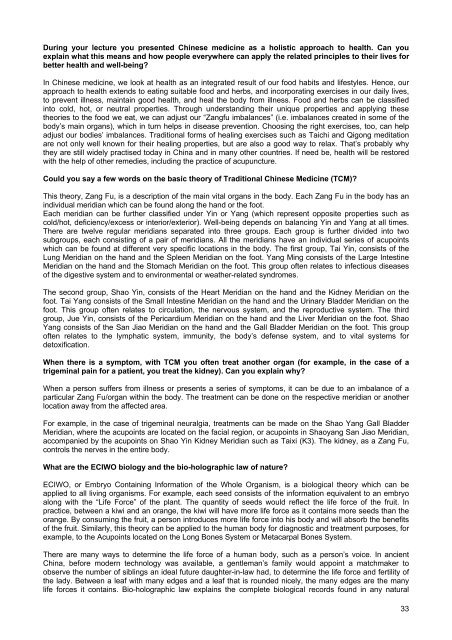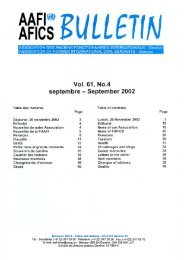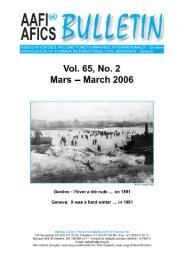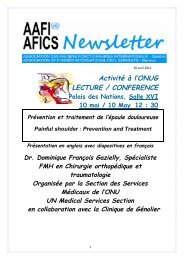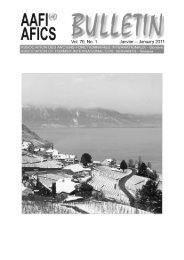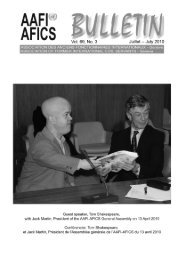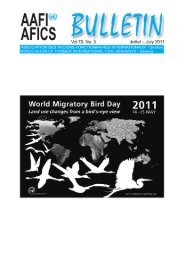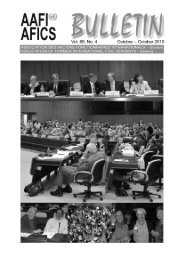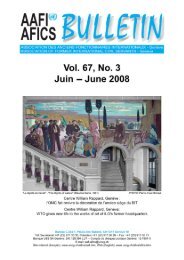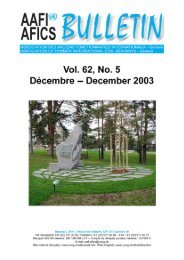VOL. 68, NO. 2 - AAFI-AFICS, Geneva - UNOG
VOL. 68, NO. 2 - AAFI-AFICS, Geneva - UNOG
VOL. 68, NO. 2 - AAFI-AFICS, Geneva - UNOG
Create successful ePaper yourself
Turn your PDF publications into a flip-book with our unique Google optimized e-Paper software.
During your lecture you presented Chinese medicine as a holistic approach to health. Can you<br />
explain what this means and how people everywhere can apply the related principles to their lives for<br />
better health and well-being?<br />
In Chinese medicine, we look at health as an integrated result of our food habits and lifestyles. Hence, our<br />
approach to health extends to eating suitable food and herbs, and incorporating exercises in our daily lives,<br />
to prevent illness, maintain good health, and heal the body from illness. Food and herbs can be classified<br />
into cold, hot, or neutral properties. Through understanding their unique properties and applying these<br />
theories to the food we eat, we can adjust our “Zangfu imbalances” (i.e. imbalances created in some of the<br />
body’s main organs), which in turn helps in disease prevention. Choosing the right exercises, too, can help<br />
adjust our bodies’ imbalances. Traditional forms of healing exercises such as Taichi and Qigong meditation<br />
are not only well known for their healing properties, but are also a good way to relax. That’s probably why<br />
they are still widely practised today in China and in many other countries. If need be, health will be restored<br />
with the help of other remedies, including the practice of acupuncture.<br />
Could you say a few words on the basic theory of Traditional Chinese Medicine (TCM)?<br />
This theory, Zang Fu, is a description of the main vital organs in the body. Each Zang Fu in the body has an<br />
individual meridian which can be found along the hand or the foot.<br />
Each meridian can be further classified under Yin or Yang (which represent opposite properties such as<br />
cold/hot, deficiency/excess or interior/exterior). Well-being depends on balancing Yin and Yang at all times.<br />
There are twelve regular meridians separated into three groups. Each group is further divided into two<br />
subgroups, each consisting of a pair of meridians. All the meridians have an individual series of acupoints<br />
which can be found at different very specific locations in the body. The first group, Tai Yin, consists of the<br />
Lung Meridian on the hand and the Spleen Meridian on the foot. Yang Ming consists of the Large Intestine<br />
Meridian on the hand and the Stomach Meridian on the foot. This group often relates to infectious diseases<br />
of the digestive system and to environmental or weather-related syndromes.<br />
The second group, Shao Yin, consists of the Heart Meridian on the hand and the Kidney Meridian on the<br />
foot. Tai Yang consists of the Small Intestine Meridian on the hand and the Urinary Bladder Meridian on the<br />
foot. This group often relates to circulation, the nervous system, and the reproductive system. The third<br />
group, Jue Yin, consists of the Pericardium Meridian on the hand and the Liver Meridian on the foot. Shao<br />
Yang consists of the San Jiao Meridian on the hand and the Gall Bladder Meridian on the foot. This group<br />
often relates to the lymphatic system, immunity, the body’s defense system, and to vital systems for<br />
detoxification.<br />
When there is a symptom, with TCM you often treat another organ (for example, in the case of a<br />
trigeminal pain for a patient, you treat the kidney). Can you explain why?<br />
When a person suffers from illness or presents a series of symptoms, it can be due to an imbalance of a<br />
particular Zang Fu/organ within the body. The treatment can be done on the respective meridian or another<br />
location away from the affected area.<br />
For example, in the case of trigeminal neuralgia, treatments can be made on the Shao Yang Gall Bladder<br />
Meridian, where the acupoints are located on the facial region, or acupoints in Shaoyang San Jiao Meridian,<br />
accompanied by the acupoints on Shao Yin Kidney Meridian such as Taixi (K3). The kidney, as a Zang Fu,<br />
controls the nerves in the entire body.<br />
What are the ECIWO biology and the bio-holographic law of nature?<br />
ECIWO, or Embryo Containing Information of the Whole Organism, is a biological theory which can be<br />
applied to all living organisms. For example, each seed consists of the information equivalent to an embryo<br />
along with the “Life Force” of the plant. The quantity of seeds would reflect the life force of the fruit. In<br />
practice, between a kiwi and an orange, the kiwi will have more life force as it contains more seeds than the<br />
orange. By consuming the fruit, a person introduces more life force into his body and will absorb the benefits<br />
of the fruit. Similarly, this theory can be applied to the human body for diagnostic and treatment purposes, for<br />
example, to the Acupoints located on the Long Bones System or Metacarpal Bones System.<br />
There are many ways to determine the life force of a human body, such as a person’s voice. In ancient<br />
China, before modern technology was available, a gentleman’s family would appoint a matchmaker to<br />
observe the number of siblings an ideal future daughter-in-law had, to determine the life force and fertility of<br />
the lady. Between a leaf with many edges and a leaf that is rounded nicely, the many edges are the many<br />
life forces it contains. Bio-holographic law explains the complete biological records found in any natural<br />
33


